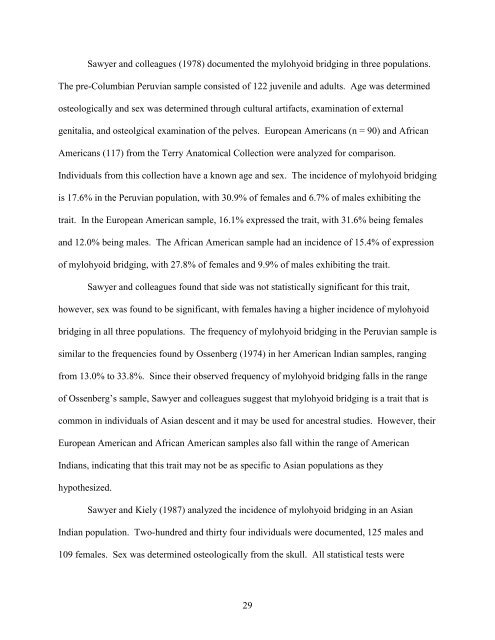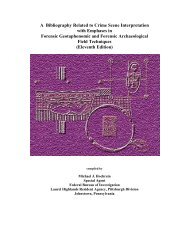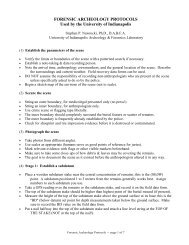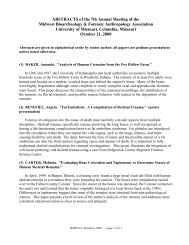Christopher W. Schmidt - University of Indianapolis Archeology ...
Christopher W. Schmidt - University of Indianapolis Archeology ...
Christopher W. Schmidt - University of Indianapolis Archeology ...
Create successful ePaper yourself
Turn your PDF publications into a flip-book with our unique Google optimized e-Paper software.
Sawyer and colleagues (1978) documented the mylohyoid bridging in three populations.<br />
The pre-Columbian Peruvian sample consisted <strong>of</strong> 122 juvenile and adults. Age was determined<br />
osteologically and sex was determined through cultural artifacts, examination <strong>of</strong> external<br />
genitalia, and osteolgical examination <strong>of</strong> the pelves. European Americans (n = 90) and African<br />
Americans (117) from the Terry Anatomical Collection were analyzed for comparison.<br />
Individuals from this collection have a known age and sex. The incidence <strong>of</strong> mylohyoid bridging<br />
is 17.6% in the Peruvian population, with 30.9% <strong>of</strong> females and 6.7% <strong>of</strong> males exhibiting the<br />
trait. In the European American sample, 16.1% expressed the trait, with 31.6% being females<br />
and 12.0% being males. The African American sample had an incidence <strong>of</strong> 15.4% <strong>of</strong> expression<br />
<strong>of</strong> mylohyoid bridging, with 27.8% <strong>of</strong> females and 9.9% <strong>of</strong> males exhibiting the trait.<br />
Sawyer and colleagues found that side was not statistically significant for this trait,<br />
however, sex was found to be significant, with females having a higher incidence <strong>of</strong> mylohyoid<br />
bridging in all three populations. The frequency <strong>of</strong> mylohyoid bridging in the Peruvian sample is<br />
similar to the frequencies found by Ossenberg (1974) in her American Indian samples, ranging<br />
from 13.0% to 33.8%. Since their observed frequency <strong>of</strong> mylohyoid bridging falls in the range<br />
<strong>of</strong> Ossenberg’s sample, Sawyer and colleagues suggest that mylohyoid bridging is a trait that is<br />
common in individuals <strong>of</strong> Asian descent and it may be used for ancestral studies. However, their<br />
European American and African American samples also fall within the range <strong>of</strong> American<br />
Indians, indicating that this trait may not be as specific to Asian populations as they<br />
hypothesized.<br />
Sawyer and Kiely (1987) analyzed the incidence <strong>of</strong> mylohyoid bridging in an Asian<br />
Indian population. Two-hundred and thirty four individuals were documented, 125 males and<br />
109 females. Sex was determined osteologically from the skull. All statistical tests were<br />
29








